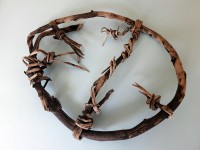 On August 5th, 2003, Simone Bartolini, cartographer and head of the State Borders division of Italy’s Military Geographical Institute, was in the Pfossental Valley in the Italian Dolomites doing a topographical survey of the border with Austria when he came across an old snowshoe made by hand out of birch and twine. A birch stick about 1.5 meters (five feet) long had been shaped into a rough oval closed with twine, and then more twine stretched taughtly across the middle to support the foot. One of the twine supports was broken in the middle, but otherwise it was in excellent condition.
On August 5th, 2003, Simone Bartolini, cartographer and head of the State Borders division of Italy’s Military Geographical Institute, was in the Pfossental Valley in the Italian Dolomites doing a topographical survey of the border with Austria when he came across an old snowshoe made by hand out of birch and twine. A birch stick about 1.5 meters (five feet) long had been shaped into a rough oval closed with twine, and then more twine stretched taughtly across the middle to support the foot. One of the twine supports was broken in the middle, but otherwise it was in excellent condition.
Bartolini thought it was maybe a hundred years old, the rudimentary work of a local farmer perhaps, and hung it on the wall of his office in Florence as a charming curiosity. That’s where it remained for 12 years until 2015 when Bartolini attended an exhibition of artifacts found in the glaciers at the Archaeological Museum of Bolzano. After a conversation with museum director Angelika Fleckinger, it dawned on him that his snowshoe might be a lot older than he had realized, so he gave it to the Office of Archaeological Heritage of Bolzano for further study.
Researchers had it radiocarbon dated by two independent laboratories and their results were the same: the snowshoe was made in the late Neolithic, between 3800 and 3700 B.C. That makes it 5,800 years old, by far the oldest known snowshoe.
“The shoe is evidence that people in the Neolithic period were living in the Alps area and had equipped themselves accordingly,” said Dr Catrin Marzoli, the director of the province’s cultural heritage department.
It was unclear why people were travelling through such an inhospitable region, she said. They may have been hunting animals, fleeing enemies from a rival tribe, or visiting pagan sites of worship.
If you live in an environmentally challenging region, you adapt. People gotta move sometimes for any number of reasons. The snowshoe was found at an altitude of 3,134 meters (10,280 feet) in the Gurgler Eisjoch pass which has been used by mountain travelers for thousands of years. Ötzi the Iceman, whose naturally mummified body was found just a few miles west of the snowshoe in 1991, was treading that well-worn trail between what are now Italy and Austria when he was killed, and microscopic evidence in his bones and digestive system indicate he had trod that path many times in his life. Ötzi died 500 years after that snowshoe was made.
The snowshoe will now join the Iceman on display at the South Tyrol Museum of Archaeology in Bolzano.